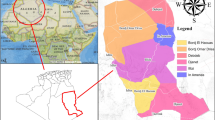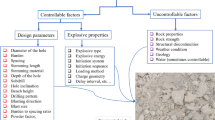Abstract
This paper highlights the performance of a radial basis function (RBF) network for ore grade estimation in an offshore placer gold deposit. Several pertinent issues including RBF model construction, data division for model training, calibration and validation, and efficacy of the RBF network over the kriging and the multilayer perceptron models have been addressed in this study. For the construction of the RBF model, an orthogonal least-square algorithm (OLS) was used. The efficacy of this algorithm was testified against the random selection algorithm. It was found that OLS algorithm performed substantially better than the random selection algorithm. The model was trained using training data set, calibrated using calibration data set, and finally validated on the validation data set. However, for accurate performance measurement of the model, these three data sets should have similar statistical properties. To achieve the statistical similarity properties, an approach utilizing data segmentation and genetic algorithm was applied. A comparative evaluation of the RBF model against the kriging and the multilayer perceptron was then performed. It was seen that the RBF model produced estimates with the R 2 (coefficient of determination) value of 0.39 as against of 0.19 for the kriging and of 0.18 for the multilayer perceptron.






Similar content being viewed by others
References
Chen, S., Cowan, C. F. N., and Grant, P. M., 1991, Orthogonal least-squares learning algorithms for radial basis function networks: IEEE Trans. Neural Netw., v. 2, no. 3, p. 302–309.
Chatterjee, S., Bhattacherjee, A., Samanta, B., and Pal, S. K., 2006, Ore grade estimation of a limestone deposit in India using artificial neural network: Appl. GIS, v. 2, no. 1, p. 2.1–2.20.
Chilès, J. P., and Delfiner, P., 1999, Geostatistics modelling spatial uncertainty: Wiley-Interscience, New York, p. 720.
Goldberg, D. E., 2000, Genetic algorithms in search, optimization, and machine learning: Pearson Education Asia Pte Ltd., p. 412.
Haykins, S., 1999, Neural networks: a comprehensive foundation (2nd edn.): Prentice Hall, New Jersey, p. 824.
Howlett, J. R., and Jain, C. J., 2001, Radial Basis function networks 2: Physica-Verlag, Heidelberg, New York, p. 357.
Journel, A. G., 1982, The indicator approach to estimation of spatial distributions: Proceedings of the 17th APCOM International Symposium, AIME, New York, p. 793–806.
Kapageridis, I. K., 2005, Input space configuration effects in neural network-based grade estimation: Comput. Geosci., v. 31, no. 6, p. 704–717.
Ke, J., 2002, Neural-network modeling of placer ore grade spatial variability: doctoral dissertation: University of Alaska Fairbanks, USA, p. 251.
Koike, K., Matsuda, S., Suzuki, T., and Ohmi, M., 2002, Neural network-based estimation of principal metal contents in the Hokuroku district, Northern Japan, for exploring Kuroko-type deposits: Nat. Resour. Res., v. 11, no. 2, p. 135–156.
Koike, K., and Matsuda, S., 2003, Characterizing content distributions of impurities in a limestone mine using a feed-forward neural network: Nat. Resour. Res., v. 12, no. 3, p. 209–223.
Li, C., Ye, H., and Wang, G., 2004, Nonlinear time series modeling and prediction using RBF network with improved clustering algorithm: 2004 IEEE International Conference on Systems, Man and Cybernetics, p. 3513–3518.
Longinov, N. E., 1994, Predicting pilot look-angle with a radial basis function network: IEEE Trans. Syst. Man Cybernet., v. 24, no. 10, p. 1511–1518.
Potts, M. S., and Broomhead, D. S., 1991, Time series prediction with a radial basis function neural network: SPIE Adapt. Signal Process., v. 1565, p. 255–266.
Rendu, J. M., 1980, Disjunctive Kriging: comparison of theory with actual results: Math. Geol., v. 12, no. 4, p. 305–320.
Samanta, B., Bandopadhyay, S., and Ganguli, R., 2004, Data segmentation and genetic algorithms for sparse data division in Nome placer gold grade estimation using neural network and geostatistics: Mining Explor. Geol., v. 11, p. 69–76.
Samanta, B., Bandopadhyay, S., Ganguli, R., and Dutta, S., 2004, Sparse data division using data segmentation and Kohonen Network for neural network and geostatistical ore grade modeling in Nome Offshore Placer Deposit: Nat. Resour. Res., v. 13, no. 3, p. 189–200.
Samanta, B., Ganguli, R., and Bandopadhyay, S., 2005, Comparing the predictive performance of neural networks with ordinary Kriging in a bauxite deposit: Mining Technol., v. 114, no. 3, p. 129–139.
Samanta, B., and Bandopadhyay, S., 2009, Construction of a radial basis function network using an evolutionary algorithm for grade estimation in a placer gold deposit: Comput. Geosci., v. 35, no. 8, p. 1592–1602.
Wu, X., and Zhou, Y., 1993, Reserve estimation using neural network techniques: Comput. Geosci., v. 19, no. 4, p. 567–575.
Yama, B. R., and Lineberry, G. T., 1999, Artificial neural network application for a predictive task in mining: Mining Eng., v. 51, no. 2, p. 59–64.
Powell, M. J. D., 1987, Radial basis functions for multivariable interpolation: a review, in Mason, J. C., and Cox, M. G., eds., Algorithms for Approximation: Oxford, Clarendon, p. 143–168.
Orr, M. J. L., 1996, Introduction to radial basis function network: Technical Report, Center of Cognitive Science, University of Edinburgh.
Verly, G., 1987, The multigaussian approach and its applications to the estimation of local reserves: Math. Geol., v. 15, no. 2, p. 259–286.
Acknowledgments
This study was funded by the DST under the fast tract scheme. This financial help by the DST is gratefully acknowledged.
Author information
Authors and Affiliations
Corresponding author
Appendix: Mathematical Formulation of RBF Network
Appendix: Mathematical Formulation of RBF Network
Construction of RBF network model can be viewed as a special case of a regression model, in which RBF network model can be formulated as:
where y(x) can be regarded as a dependent variable, w i’s as regression coefficients, and \( \phi_i \) as the regressors or independent variables.
For n number of data points in the training set, the above equation can be written in a matrix form
where
The regressor vectors \( \phi_i \) form a set of basis vectors, and the least-square solution of w satisfies the condition that \( w\phi \) would be the projection of y onto the space spanned by these basis vectors. As a result, the square of \( w\phi \) will indicate that part of the variance y, which is explained by these regressors. However, since the RBFs are usually correlated, it is not understood clearly as what would be the contribution of the individual regressors to this variance. The orthogonal least-square algorithm assists to resolve this problem. The algorithm transforms a set of \( \phi_i \) into a set of orthogonal basis vectors, thus making it possible to count individual contribution of the basis vector to explain the total variance. The regression matrix \( \phi \) can be decomposed into \( \phi=RA \), where A is a M × M matrix with 1’s on the diagonal and 0’s below the diagonal
and R is an n × m matrix with orthogonal columns r i such that
The space spanned by a set of regressors \( \phi_i \) will be the same space spanned the sets of orthogonal basis vectors r i. Hence, Eq. A1 can be rewritten as
The orthogonal least-square solution g is given by
The quantities \( \hat{g} \) and \( \hat{w} \) satisfy the triangular matrix A
The classical Gram-Schmidt algorithm can be used to derive Eq. A2 and thus the LS estimate of \( \hat{w} \). The well-known Gram-Schmidt method computes one column of A at a time and orthogonalizes \( \phi \) as follows: at the kth stage, the kth column of the matrix is made orthogonal to each of the k − 1 previously orthogonalized columns and the process is repeated for k = 2,…, m. The computational procedure can be represented as
The OLS has superior numerical properties than the simple LS method. However, main usage of the OLS method in this study is to select the most significant RBFs from the whole set of RBFs in a forward regression manner. Because r i and r j are orthogonal when \( i \ne j \), the sum of square of y i,
If y is the desired output vector after mean is removed, then the variance of y is given by
It can be seen that \( N^{ - 1} \sum\limits_{i = 1}^{m} {g_{i}^{2} r_{i}^{\text{T}} r_i} \) is a part of the desired output variance which is explained by the regressors, and \( N^{ - 1} \varepsilon^{\text{T}} \varepsilon \) is the error variance. Hence \( \frac{1}{N}g_{i}^{2} r_{i}^{\text{T}} r_{i} \) is the incremental variance explained by the regressor r i , after its introduction into the regression model, and an error reduction ratio due to r i can be defined as
This ratio offers a simple and effective means of selecting a radial basis function in a forward regression manner.
Rights and permissions
About this article
Cite this article
Samanta, B. Radial Basis Function Network for Ore Grade Estimation. Nat Resour Res 19, 91–102 (2010). https://doi.org/10.1007/s11053-010-9115-z
Received:
Accepted:
Published:
Issue Date:
DOI: https://doi.org/10.1007/s11053-010-9115-z




